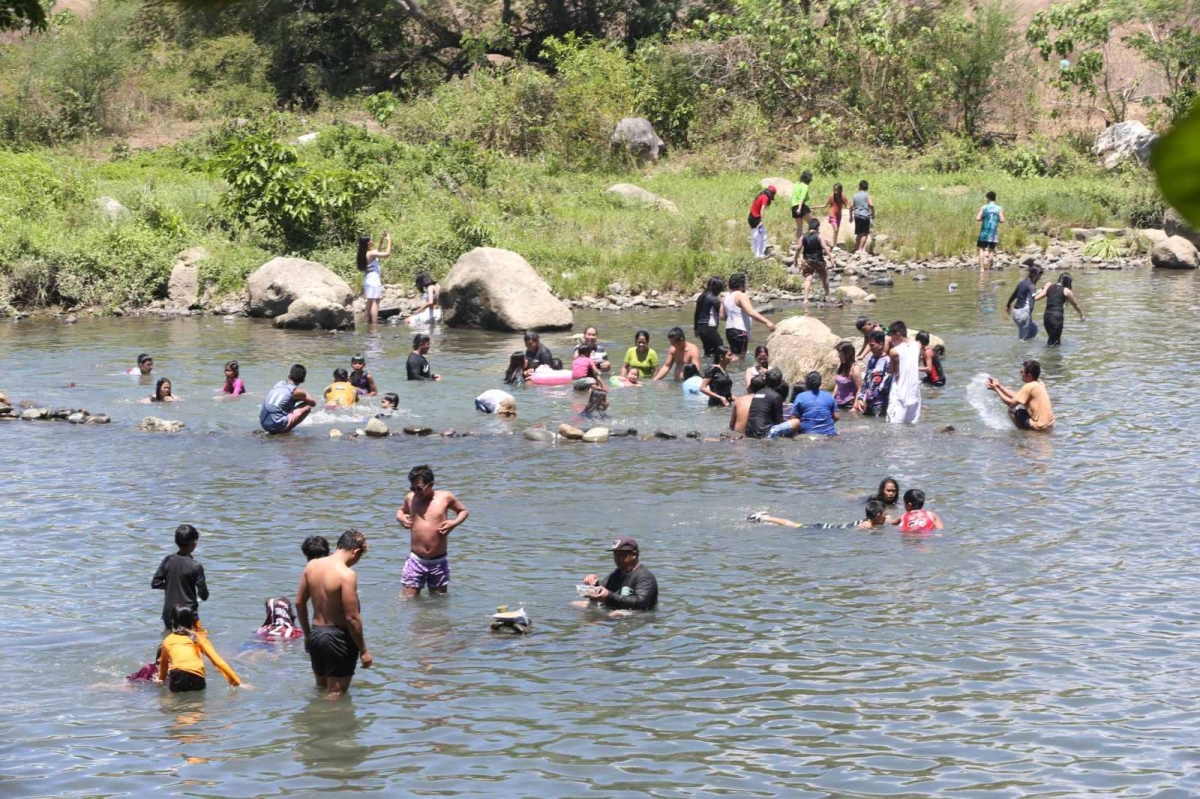Table of Contents
These warm winds, combined with the high pressure area over the Pacific Ocean, are causing the uncomfortable heat index as Philippine temperature rises. The heat index is a measure of how hot it feels when relative humidity is factored in with the actual air temperature. With the humidity levels rising, the heat index is expected to reach dangerous levels, making it uncomfortable and potentially hazardous for individuals to engage in prolonged outdoor activities.
PAGASA Advisory
PAGASA advises the public to take necessary precautions to protect themselves from the extreme heat. It is recommended to stay indoors as much as possible during the hottest hours of the day, typically from 10 am to 4 pm. If going outside is unavoidable, it is important to wear light-colored and loose-fitting clothing to allow for proper ventilation and to apply sunscreen with a high SPF to protect the skin from harmful UV rays.
Furthermore, PAGASA advises individuals to stay hydrated by drinking plenty of water throughout the day, even if they do not feel thirsty. It is also crucial to avoid alcohol and caffeinated beverages as they can contribute to dehydration. Additionally, seeking shade or using an umbrella when outdoors can provide some relief from the scorching sun.
The advisory also emphasizes the importance of checking on vulnerable individuals such as the elderly, children, and those with pre-existing medical conditions. These groups are more susceptible to heat-related illnesses such as heat exhaustion or heatstroke. It is essential to ensure that they are in a cool and well-ventilated environment and are adequately hydrated.
PAGASA will continue to monitor the weather conditions closely and provide updates and advisories as necessary. The agency urges the public to stay informed through official channels and to follow the guidelines and recommendations provided to ensure their safety and well-being during this period of extreme heat. By taking these precautions, individuals can minimize the risks associated with prolonged exposure to high temperatures and enjoy a safe and comfortable summer season.
Understanding the Impact of Heat on Outdoor Activities
Castaneda emphasizes the importance of limiting outdoor activities during the increase in Philippine temperature. The period from noontime to mid-afternoon experiences the highest temperatures, making it crucial for individuals to take necessary precautions to protect themselves from the scorching heat. It is recommended that those who cannot avoid going outside should bring items such as hats, umbrellas, and sunscreen to shield themselves from direct exposure to the sun. Additionally, it is essential to stay hydrated by drinking plenty of water to prevent dehydration.
Moreover, understanding the impact of heat on outdoor activities is crucial for maintaining overall well-being. Exposure to high temperatures for prolonged periods can lead to heat-related illnesses such as heat exhaustion and heatstroke. Heat exhaustion is a condition characterized by heavy sweating, dizziness, nausea, and fatigue. If left untreated, it can progress to heatstroke, which is a life-threatening emergency that requires immediate medical attention.
Furthermore, the impact of heat on outdoor activities extends beyond physical health. It can also affect cognitive functioning and mental well-being. Research has shown that heat stress can impair cognitive performance, leading to decreased alertness, concentration, and decision-making abilities. This can have significant implications for individuals engaging in outdoor activities that require mental focus, such as sports, hiking, or even working in hot environments.
In addition to the immediate effects, the long-term impact of heat on outdoor activities should also be considered. With the increasing frequency and intensity of heatwaves due to climate change, individuals who regularly participate in outdoor activities may be at a higher risk of developing chronic health conditions. Prolonged exposure to high temperatures can contribute to the development of cardiovascular diseases, respiratory problems, and even certain types of cancer.
Therefore, it is crucial for individuals to be aware of the potential risks associated with high Philippine temperature and the appropriate measures to protect themselves when engaging in outdoor activities. This includes not only physical precautions such as wearing protective clothing and staying hydrated but also being mindful of the timing and duration of outdoor activities. Choosing to exercise or engage in recreational activities during cooler hours of the day, such as early morning or late evening, can significantly reduce the risk of heat-related illnesses and ensure a safer and more enjoyable experience.
Understanding the impact of heat on outdoor activities is vital for maintaining both physical and mental well-being. By being aware of the potential risks and taking necessary precautions, individuals can protect themselves from heat-related illnesses and enjoy outdoor activities safely. It is essential to prioritize personal safety and make informed decisions when engaging in outdoor activities, especially during periods of high temperatures.
One of the key factors that contribute to the heat index is relative humidity. When the air is humid, it becomes more difficult for sweat to evaporate from the skin, which is the body’s natural cooling mechanism. As a result, individuals may feel hotter than the actual air temperature, and their bodies may struggle to regulate their internal temperature.
In addition to relative humidity, other factors such as air movement and exposure to direct sunlight can also affect the heat index. For example, when there is a breeze, it can help to evaporate sweat more efficiently, providing some relief from the heat. On the other hand, being in direct sunlight can increase the heat index, as the sun’s rays can intensify the feeling of heat on the body.
Understanding the heat index is particularly important during extreme heat as Philippine Temperature increased. These conditions can pose serious health risks, especially for vulnerable populations such as the elderly, young children, and individuals with certain medical conditions. Heat-related illnesses can range from mild symptoms such as heat cramps and heat rash to more severe conditions like heat exhaustion and heat stroke, which can be life-threatening.
To prevent heat-related illnesses, it is essential to stay hydrated by drinking plenty of water throughout the day. Wearing light-colored, loose-fitting clothing can also help to keep the body cool. Additionally, seeking shade or air-conditioned environments during the hottest parts of the day can provide relief from the heat.
Furthermore, it is crucial to be aware of the signs and symptoms of heat-related illnesses. These may include dizziness, nausea, rapid heartbeat, headache, and confusion. If you or someone around you experiences these symptoms, it is important to seek medical attention immediately.
Importance of Heat Index
The heat index is a valuable tool for understanding how weather conditions truly feel to individuals. By considering factors such as air temperature, relative humidity, air movement, and sunlight exposure, the heat index provides a more accurate measure of the impact of heat on the human body.
By taking necessary precautions and being aware of the signs of heat-related illnesses, individuals can stay safe and healthy during periods of high heat index values. Furthermore, it is essential to be aware of the local laws and customs regarding outdoor activities in hot weather to avoid any legal issues or cultural misunderstandings.
For instance, in some areas, it may be considered disrespectful or even illegal to expose too much skin in public, especially in religious or conservative communities. Therefore, it is advisable to dress modestly and respectfully, opting for lightweight, breathable clothing that covers the shoulders and knees.
Additionally, it is crucial to stay hydrated and protect oneself from the harmful effects of high Philippine Temperature. In many countries with hot climates, it is common to see locals carrying umbrellas or wearing wide-brimmed hats to shield themselves from direct sunlight. Sunscreen with a high SPF is also recommended to prevent sunburn and reduce the risk of skin damage.
Risk of High Philippine Temperature
Furthermore, it is important to be aware of the risks of heat-related illnesses and take necessary precautions. This includes avoiding strenuous activities during the hottest parts of the day, seeking shade whenever possible, and drinking plenty of water to stay hydrated. It is also advisable to familiarize oneself with the signs and symptoms of heat exhaustion and heatstroke, such as dizziness, nausea, rapid heartbeat, and confusion, and to seek medical help if any of these symptoms occur.
Moreover, it is worth noting that local communities may have their own customs and traditions related to hot weather. For example, in some areas, it may be customary to take a siesta or midday nap to avoid the hottest hours of the day.
Source: The Manila Times







